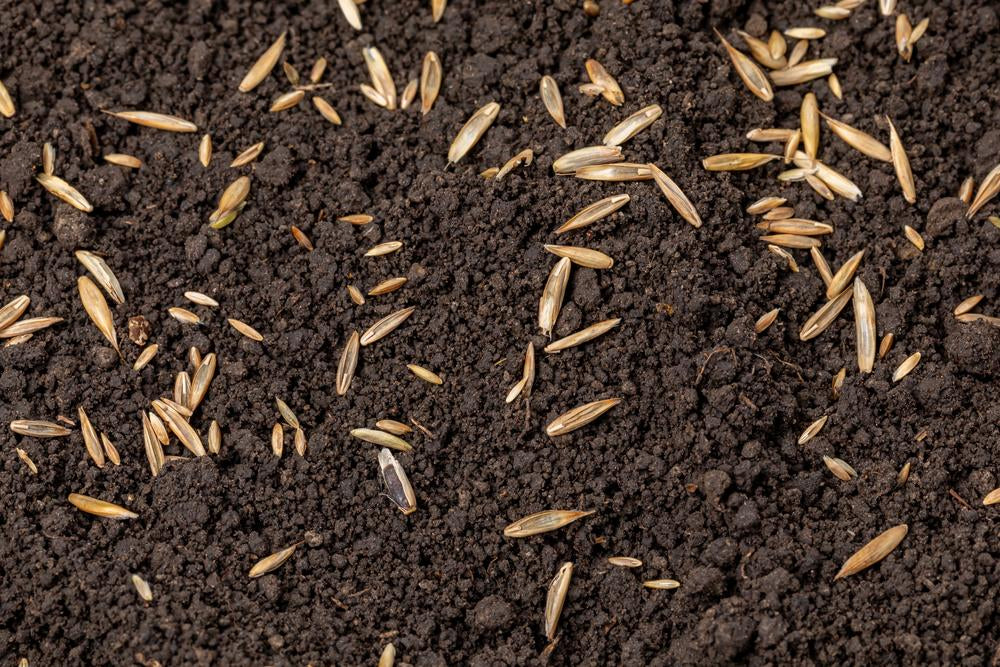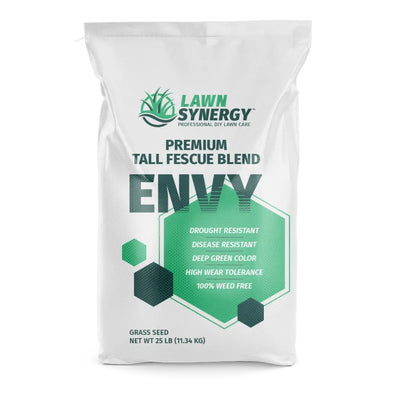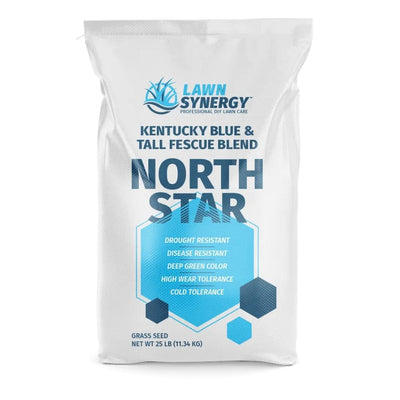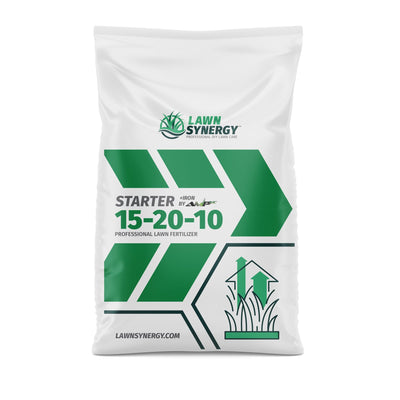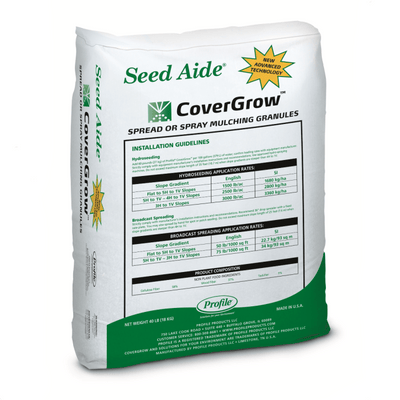If you're asking how much grass seed do I need, you're already on the right track. Getting this number right sets the foundation for dense, weed-resistant turf. Get it wrong, and you're wasting time, money, and opportunity.
Let's walk through the process of calculating exactly how much seed you need, based on your grass type, project goals, and lawn conditions, so you get professional results without the guesswork.
What this article covers:
- Why Seeding Rate Matters for a Healthy Lawn
- How to Calculate How Much Grass Seed You Need
- Seeding Rates by Grass Type
- Factors That Affect How Much Seed You'll Use
- Overseeding vs. New Lawn: Seed Amounts Compared
- Lawn Synergy Recommendations for Seeding Success
Why Seeding Rate Matters for a Healthy Lawn
Seeding rate directly affects germination success, canopy density, and long-term turf health. Apply too little seed, and you'll create open space between seedlings, leaving the door wide open for weeds, soil erosion, and moisture loss.
Apply too much, and seedlings compete for limited light, water, and nutrients, often resulting in weak, leggy growth or dieback.
Each grass variety has an optimal pounds-per-1,000-square-feet range based on its seed size, tillering rate, and canopy spread.
For example, turf-type tall fescue has a larger seed and fewer tillers than Kentucky bluegrass, so it requires a higher seeding rate to fill in evenly. That's why tall fescue is typically seeded at 8 to 10 lbs per 1,000 sq. ft. for new lawns, compared to 2 to 3 lbs for bluegrass.
Inconsistent seeding also causes variable germination times, which makes watering and fertilization harder to manage.
Areas with too much seed may form dense mats that retain excess moisture, while underseeded zones may dry out or crust over before roots can establish.
To avoid these issues, base your seeding rate on measured square footage, follow the specific rate for your seed type, and calibrate your spreader properly.

How to Calculate How Much Grass Seed You Need
Start with square footage. Measure your lawn area (length × width), subtract hardscape areas, and determine whether you're starting fresh or overseeding.
Then use the seeding rate for your grass type to calculate pounds of seed needed.
The general formula looks like this:
Lawn area (sq. ft.) ÷ 1,000 × recommended lbs per 1,000 sq. ft. = total lbs needed
For example, if you have a 3,000-square-foot yard and you're seeding tall fescue for a new lawn at 8 lbs per 1,000 sq. ft..:
3,000 ÷ 1,000 = 3
3 × 8 lbs = 24 lbs of seed needed
How to Measure Your Lawn Area Accurately
Many homeowners over- or underestimate their lawn size. Don't guess—measure. Use a tape measure or a free online mapping tool like Google Maps area calculator. Break your lawn into sections (rectangles or circles), then add them together.
Example:
Front yard: 30 ft × 40 ft = 1,200 sq. ft.
Backyard: 40 ft × 50 ft = 2,000 sq. ft.
Total = 3,200 sq. ft.
Seeding Rates by Grass Type
Different grass species have different seed sizes, growth patterns, and establishment needs, so their seeding rates vary. Always follow the rate listed on the bag or consult reliable agronomic sources like your state extension service.
Tall Fescue (New Lawn)
Seeding Rate: 8–10 lbs per 1,000 sq. ft.
Best for full sun to partial shade. Recommended throughout the Southeast and Mid-Atlantic, including North Carolina. Offers excellent drought tolerance and deep rooting.

Tall Fescue (Overseeding)
Seeding Rate: 4–6 lbs per 1,000 sq. ft.
Ideal for thickening an existing stand or repairing patchy areas. Use less than a new lawn application to avoid overcrowding.
Bermuda Grass (New Lawn)
Seeding Rate: 1–2 lbs per 1,000 sq. ft.
Fine-textured, warm-season grass with high germination and aggressive lateral spread. Performs best in hot, sunny regions.
Bahia Grass (New Lawn)
Seeding Rate: 5–10 lbs per 1,000 sq. ft.
Tolerates drought, heat, and sandy soils. If you're exploring how to plant bahia grass seed, remember it prefers acidic, low-input soil and thrives in full sun.
Ryegrass (Temporary or Cool Season Cover)
Seeding Rate: 5–10 lbs per 1,000 sq. ft.
Used for quick cover or winter color in southern lawns. Germinates rapidly and establishes quickly, but does not persist through heat in most climates.
Factors That Affect How Much Seed You'll Use
Your seeding rate may need to increase or decrease depending on your unique lawn conditions.
- Lawn condition: Thin, compacted, or heavily thatched lawns may need more seed to establish even growth. Use a dethatcher or aerator if necessary.
- Seeding method: Broadcast spreaders may require a higher rate due to overlap loss. Slit seeders place seed directly into the soil, improving efficiency.
- Soil type: Hard clay or sandy soils affect seed-to-soil contact and moisture retention. You may lose some seed to runoff or evaporation, so slightly higher rates may be needed.
- Timing: Early fall is ideal for most cool-season grasses. Spring seeding is possible but comes with higher competition from weeds and variable moisture.

Overseeding vs. New Lawn: Seed Amounts Compared
When overseeding, your base is already in place. You're not trying to fill bare soil, just thicken the canopy and outcompete weeds.
That means you'll use about half the amount of seed per 1,000 square feet compared to a full renovation.
Overseeding Application:
- Tall fescue: 4–6 lbs per 1,000 sq. ft.
- Ryegrass: 5–8 lbs per 1,000 sq. ft.
Use a lighter setting on your spreader, and overlap passes to fill in any gaps. For large projects or patchy lawns, measure coverage in sections and track your application rate.
Lawn Synergy Recommendations for Seeding Success
We've managed estate lawns across the Southeast for over 30 years. Here's how we set our customers up for success.
1. Choose the Right Seed
Not all grass seed is created equal. Low-grade mixes often contain filler, weed seed, or incompatible species that won't thrive in your region.
We recommend tested, professional-grade varieties like Envy Premium Tall Fescue Grass Seed Blend for durable, fine-bladed turf, or Lesco All Pro Transition Tall Fescue for high-traffic residential lawns. These are bred for deep root systems, strong disease resistance, and consistent texture.
2. Prepare the Soil
Healthy germination starts underground. Compacted or crusted soil creates a barrier to both root penetration and water movement.
Use a core aerator or steel rake to open the top 1 to 2 inches of soil and remove debris like thatch or stones. This improves oxygen flow and allows seedlings to anchor more quickly.
Before seeding, apply a starter phosphorus source such as 0-46-0 Triple Superphosphate. Phosphorus doesn't move much in soil, so it needs to be in place from the start to support early root development.
A single pass at the recommended rate is enough to prime the root zone without burning seedlings.

3. Seed and Water Strategically
Apply your seed with a properly calibrated rotary or drop spreader, following the product's listed setting. For even coverage, split your seed into two passes: one horizontal, one vertical. This helps fill in gaps and prevents stripping.
Watering is where most DIY projects fall short. For the first 10 to 14 days, water lightly two to three times per day to keep the surface moist, but never saturated. Once seedlings emerge, reduce frequency and increase depth to encourage downward root growth.
If you're unsure how often to water grass seed, follow our complete stage-based guide to time your irrigation precisely based on grass type and weather.
Avoid watering at night. Cool, wet conditions promote disease. Stick to morning and late afternoon cycles during germination.
4. Apply Nutrients as Seedlings Mature
After your new grass reaches 1.5 to 2 inches in height and has been mowed once, it's time to feed. Use a balanced, slow-release product like Almighty 20-0-10 to promote steady top growth without overstimulating blade length too quickly.
This nitrogen-forward blend supports chlorophyll production and density, while the potassium boosts disease resistance and root resilience as the lawn matures.
Avoid high-nitrogen quick-release fertilizers during early growth, as they can stress immature roots or cause spindly shoots.
Conclusion
Knowing how much grass seed you need is one of the most important steps in building a healthy, full lawn. It shapes everything that follows — from watering to weed control to fertilizer timing.
With the right math, the right product, and a plan tailored to your property, you'll get dense, professional-grade results without overspending or overseeding.
At Lawn Synergy, we provide expert-backed products so every DIYer can seed with confidence. Explore our full range of pro-grade grass seed and lawn fertilizers, or contact us directly for help with seeding, timing, and turf care strategy.
Ready to learn more about lawn care? Check out these articles:

